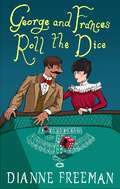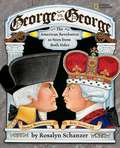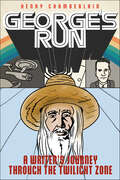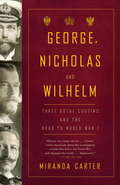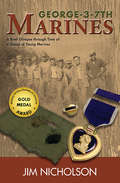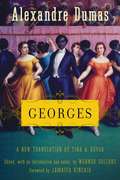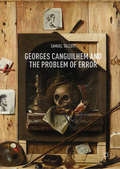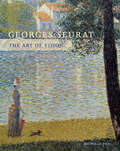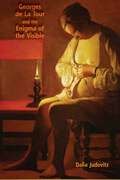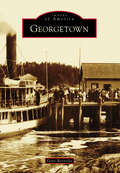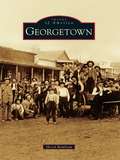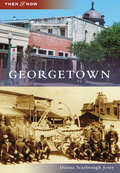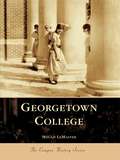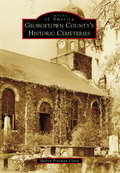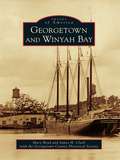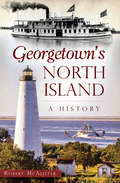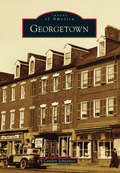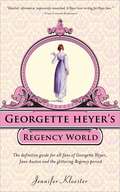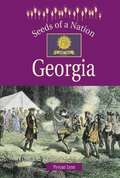- Table View
- List View
George and Frances Roll the Dice (A Countess of Harleigh Mystery)
by Dianne FreemanIn this Victorian-era mystery novella, the Countess of Harleigh, Frances Hazelton, and her husband, George, discover that a French seaside resort is a fetching backdrop for business, pleasure...and murder. Frances and George arrive in Deauville by the sea to enjoy a long-awaited honeymoon. It&’s also an opportunity for George to inspect a villa inherited by his ward and arrange for its sale. To the Hazeltons&’ surprise, they find it inhabited by wealthy revelers playing an illegal game of Hazard—forbidden fun, hosted by Albert Roth, a charismatic professional gambler who has a lease and no desire to vacate. The discovery doesn&’t sit well with Frances and George. Especially since Albert also fixes horse races and polo matches and is said to pay off authorities who turn a blind eye to his criminal endeavors. But not anymore. The Hazeltons plan to break up the party. Yet the game abruptly changes when a popular British polo player who claims to have lost a fortune to Albert is found murdered in the villa&’s salon. Now Frances and George have to do more than prove ownership of the valuable Normandy coast property. They have to find a killer. They&’re sure all roads lead to Albert. But in a world of bribery, loansharking, corruption, and high society risks, nothing is what it seems. And for the Hazeltons, the stakes are getting higher...
George vs. George: The American Revolution as Seen from Both Sides
by Rosalyn SchanzerThere are two sides to every story. Rosalyn Schanzer's engaging and wonderfully illustrated book brings to life both sides of the American Revolution. The narrative introduces anew the two enemies, both named George: George Washington, the man who freed the American colonies from the British, and George III, the British king who lost them. Two leaders on different sides of the Atlantic, yet with more in common than we sometimes acknowledge. We are lead through their story, and the story of their times, and see both sides of the arguments that divided the colonies from the Kingdom. Was King George a "Royal Brute" as American patriots claimed? Or was he, as others believed, "the father of the people?" Was George Washington a scurrilous traitor, as all the king's supporters claimed? Or should we remember and celebrate him as "the father of his country?" Who was right? History teaches us that there are two sides to every story. Rosalyn Schanzer's book is an accessible account of one the most vital periods in American history. It is also a timeless lesson in seeing history from different points of view. The author spent two years researching books, paintings, cartoons, and descriptions of Revolutionary times. She uses art, text, and first-hand accounts to illustrate how history should never be reduced to simplistic conflicts between the "good guys" and the "bad guys. " Her illustrations, and her engaging quote bubbles, bring the Revolution to life again, and allow the characters of the period to speak for themselves. Through its lively text, detailed illustrations, and fully authenticated quotes, George vs. George shines fresh light on both sides of the story of our country's formative years.
George's Run: A Writer's Journey through the Twilight Zone
by Henry ChamberlainGeorge Clayton Johnson was an up-and-coming short story writer who broke into Hollywood in a big way when he co-wrote the screenplay for Ocean’s Eleven. More legendary works followed, including Logan’s Run and classic scripts for shows like The Twilight Zone and Star Trek. In the meantime, he forged friendships with some of the era’s most visionary science fiction writers, including Ray Bradbury, Theodore Sturgeon, Richard Matheson, and Rod Serling. Later in life, Johnson befriended comics journalist and artist Henry Chamberlain, and the two had long chats about his amazing life and career. Now Chamberlain pays tribute to his late friend in the graphic novel George’s Run, which brings Johnson’s creative milieu to life in vividly illustrated color panels. The result feels less like reading a conventional biography and more like sitting in on an intimate conversation between friends as they recollect key moments in pop culture history, as well as the colorful band of writers known as the “Rat Pack of Science Fiction.”
George, Nicholas and Wilhelm: Three Royal Cousins and the Road to World War I
by Miranda CarterIn the years before the First World War, the great European powers were ruled by three first cousins: King George V of Britain, Kaiser Wilhelm II of Germany and Tsar Nicholas II of Russia. Together, they presided over the last years of dynastic Europe and the outbreak of the most destructive war the world had ever seen, a war that set twentieth-century Europe on course to be the most violent continent in the history of the world. Miranda Carter uses the cousins’ correspondence and a host of historical sources to tell the tragicomic story of a tiny, glittering, solipsistic world that was often preposterously out of kilter with its times, struggling to stay in command of politics and world events as history overtook it. George, Nicholas and Wilhelmis a brilliant and sometimes darkly hilarious portrait of these men—damaged, egotistical Wilhelm; quiet, stubborn Nicholas; and anxious, dutiful George—and their lives, foibles and obsessions, from tantrums to uniforms to stamp collecting. It is also alive with fresh, subtle portraits of other familiar figures: Queen Victoria—grandmother to two of them, grandmother-in-law to the third—whose conservatism and bullying obsession with family left a dangerous legacy; and Edward VII, the playboy “arch-vulgarian” who turned out to have a remarkable gift for international relations and the theatrics of mass politics. At the same time, Carter weaves through their stories a riveting account of the events that led to World War I, showing how the personal and the political interacted, sometimes to devastating effect. For all three men the war would be a disaster that destroyed forever the illusion of their close family relationships, with any sense of peace and harmony shattered in a final coda of murder, betrayal and abdication.
George-3-7th Marines: A Brief Glimpse through Time of a Group of Young Marines
by Jim NicholsonMilitary Writers Society of America Gold Medal Winner: An account of the Korean War, as told by the men who fought it. Includes photos. In the four years of the Korean War, America lost almost 54,000 men, roughly the same number who lost their lives in Vietnam, yet this war has almost disappeared into American history, often called the &“Forgotten War.&” George-3-7th Marines recounts the bloody Marine infantry campaigns fought in the deadly mountain ranges of Korea. It is the story of the men who fought—and died anonymously—in a little-known yet bloody war. These never-before-told tales of the battle-hardened Marines of G-3-7 have been collected and recorded by one of their own. Described by those who experienced the action firsthand, these accounts blend the shocking details of savage, bloody killing with gentle, almost heartbreaking prose seldom seen in a chronicle of war. Jim Nicholson paints a brutally accurate picture of America and the Valhalla culture that shaped the toughness of soldiers in the 1950s. He examines the events and mistakes that led to a collision of the free world with the rapidly expanding Communist military machine. He reminds us that the sacrifice of young American boys saved the South Koreans, who now live freely in their beautiful &“land of the morning calm.&”
Georges
by Alexandre Dumas Tina A. KoverA major new translation of a stunning rediscovered novel by Alexandre Dumas, Georges is a classic swashbuckling adventure. Brilliantly translated by Tina A. Kover in lively, fluid prose, this is Dumas’s most daring work, in which his themes of intrigue and romance are illuminated by the issues of racial prejudice and the profound quest for identity. Georges Munier is a sensitive boy growing up in the nineteenth century on the island of Mauritius. The son of a wealthy mulatto, Pierre Munier, Georges regularly sees how his father’s courage is tempered by a sense of inferiority before whites–-and Georges vows that he will be different. When Georges matures into a man committed to “moral superiority mixed with physical strength,” the stage is set for a conflict with the island’s rich and powerful plantation owner, Monsieur de Malmédie, and a forbidden romance with Sara, the beautiful woman engaged to Malmédie’s son. Swordplay, a slave rebellion, a harrowing escape, and a vow of vengeance–-Georges is unmistakably the work of the master who wrote The Three Musketeers and The Count of Monte Cristo. Yet it stands apart as the only book Dumas ever wrote that confronts the subject of race-–a potent topic, since Dumas was of African ancestry himself. This edition also features a captivating Introduction by Jamaica Kincaid and an eloquent Afterword and Notes by Werner Sollors, who addresses key themes such as colonialism, racism, African slavery, and interracial intimacy. Long out of print in America, Georges can now be appreciated as never before and added to the greatest works of this immortal author.
Georges Canguilhem and the Problem of Error
by Samuel TalcottExamining Georges Canguilhem’s enduring attention to the problem of error, from his early writings to Michel Foucault’s first major responses to his work, this pathbreaking book shows that the historian of science was also a centrally important philosopher in postwar France. Samuel Talcott elucidates Canguilhem’s contributions by drawing on previously neglected publications and archival sources to trace the continuity of commitment that led him to alter his early anti-vitalist, pacifist positions in the face of political catastrophe and concrete human problems. Talcott shows how Canguilhem critically appropriated the philosophical work of Alain, Bergson, Bachelard, and many others while developing his own distinct writings on medicine, experimentation, and scientific concepts in an ethical and political endeavor to resist alienation and injustice. And, while suggesting Canguilhem’s sometimes surprising philosophical importance for a range of younger thinkers, the book demonstrates Foucault’s own critical allegiance to Canguilhem’s spirit, techniques, and investigations.
Georges Seurat
by Michelle FoaThis revelatory study of Georges Seurat (1859-1891) explores the artist's profound interest in theories of visual perception and analyzes how they influenced his celebrated seascape, urban, and suburban scenes. While Seurat is known for his innovative use of color theory to develop his pointillist technique, this book is the first to underscore the centrality of diverse ideas about vision to his seascapes, figural paintings, and drawings. Michelle Foa highlights the importance of the scientist Hermann von Helmholtz, whose work on the physiology of vision directly shaped the artist's approach. Foa contends that Seurat's body of work constitutes a far-reaching investigation into various modes of visual engagement with the world and into the different states of mind that visual experiences can produce. Foa's analysis also brings to light Seurat's sustained exploration of long-standing and new forms of illusionism in art. Beautifully illustrated with more than 140 paintings and drawings, this book serves as an essential reference on Seurat.
Georges Vanier: The Wartime Letters and Diaries, 1915-1919
by Georges Vanier Deborah CowleyEast Sandling Camp. 1 June 1915"Captain Boyer and I are leaving for London to buy a motor car for the regiment. We will be staying at the Savoy."Flanders. 27 October 1915. Diary entry: 4:00 p.m."Returned to the trenches. After two days of rain, they are in a deplorable state. There is mud up to our knees. The parapets have collapsed in several spots. The nights are frigid, our feet are cold, and we have not yet received our supplies of wood and charcoal."In the field. 1 August 1918."You will pardon the brevity and the looseness of this letter when you know under what conditions it has been written. What you wish to know above all I can tell you at once. I am well - in fact I do not think I have ever been quite so well in body and in spirit. I have been protected in a special manner during the last three days. I have seen so many narrow escapes myself that I am beginning to think that one should not worry much about possible eventualities."No. 8 British Red Cross Hospital, Boulogne. 6 September 1918."By this time you will have received reassuring cablegrams and field postcards and possibly letters from friends of mine."First, to be quite frank, I will admit that I have not been in fit condition to write a coherent letter …"
Georges de La Tour and the Enigma of the Visible
by Dalia JudovitzNot rediscovered until the twentieth century, the works of Georges de La Tour retain an aura of mystery. At first sight, his paintings suggest a veritable celebration of light and the visible world, but this is deceptive. The familiarity of visual experience blinds the beholder to a deeper understanding of the meanings associated with vision and the visible in the early modern period.By exploring the representations of light, vision, and the visible in La Tour’s works, this interdisciplinary study examines the nature of painting and its artistic, religious, and philosophical implications. In the wake of iconoclastic outbreaks and consequent Catholic call for the revitalization of religious imagery, La Tour paints familiar objects of visible reality that also serve as emblems of an invisible, spiritual reality. Like the books in his paintings, asking to be read, La Tour’s paintings ask not just to be seen as visual depictions but to be deciphered as instruments of insight. In figuring faith as spiritual passion and illumination, La Tour’s paintings test the bounds of the pictorial image, attempting to depict what painting cannot ultimately show: words, hearing, time, movement, changes of heart.La Tour’s emphasis on spiritual insight opens up broader artistic, philosophical, and conceptual reflections on the conditions of possibility of the pictorial medium. By scrutinizing what is seen and how, and by questioning the position of the beholder, his works revitalize critical discussion of the nature of painting and its engagements with the visible world.
Georgetown
by Gene ReynoldsGeorgetown is an island located between the historic Kennebec and Sheepscot Rivers. Incorporated in l716, it was accessible from the mainland only by various ferries and local fishing boats until a bridge was erected in 1898. Maritime endeavors like fishing and shipbuilding emerged as the major industries in town very early on and continue to be a primary means of employment today. Georgetown encompasses several beautiful villages, all of which retain a feeling of an older time and place. As the area continued to grow as a destination for artists in the early 1900s, several notable photographers congregated at the Seguinland Hotel, now known as Grey Havens Inn, to discuss starting a school that would ignite the development of commercial photography. One of the most recognizable parts of Georgetown is Reid State Park, which attracts visitors with its beautiful beaches. Today, residents take pride in the new historical society building, firehouse, post office, and restored community center.
Georgetown
by Sheryl RambeauAt the beginning of the 20th century, historian Herman Daniel Jerrett noted that there was "no other part of the world with a placer seam formation filled with small gold-bearing veins and veinlets, so great or so crumpled, crushed and its fold mashed together, as that on the Georgetown Divide." First a simple base and supply camp for early miners, Georgetown survived despite repeated challenges from fires and economic slumps. Now rebuilt, it offers physical proof of the hardy pioneer spirit that settled this small town in the Sierra Nevada foothills. Historic Main Street offers numerous examples of "fireproof" architectural styles, more hopeful than realistic, including the 100-foot-wide Main Street itself, unique in Mother Lode mining towns.
Georgetown (Then and Now)
by Donna Scarbrough JoseyFounded in 1848, Georgetown's development was driven by cattle, cotton, railroads, and education. Author and Georgetown native Donna Scarbrough Josey brings the city's history to life through this remarkable collection of vintage photographs from the Georgetown Heritage Society, Williamson County Sun newspaper, Southwestern University, and private collections. Readers will explore the beautifully restored courthouse square, a railroad district revived for the 21st century, the oldest neighborhoods, Southwestern University, and storied places along the San Gabriel River.
Georgetown College (Campus History)
by Megan LemasterThe mighty columns of historic Giddings Hall reflect the rich traditions of Georgetown College. With ties stretching back to 1787, Georgetown College offers a liberal arts education "providing students with a climate for achievement with aChristian context." As the first Baptist college west of the Allegehenies, the school survived not only the turmoil of war but also a devastating fire in the midst of economic depression. Because of the faith and endurance of dedicated trustees, faculty, and local citizens, Georgetown College developed into an institution that celebrates alegacy of scholarship and Christian principles. This volume's nostalgic photographs and recent snapshots highlight Georgetown's worlds of academia, athletics, student life, and religious activity.
Georgetown County's Historic Cemeteries (Images of America)
by Sharon Freeman CoreyGeorgetown is the third-oldest city in the state of South Carolina and the county seat of Georgetown County. Named for King George III of England, Georgetown County lies on the Atlantic Ocean surrounding Winyah Bay. The county's rivers--Santee, Sampit, Black, Pee Dee, and Waccamaw--were named by the Native Americans who were the area's first inhabitants. In 1732, the land was settled by the English, French, and Scots. Their first staple crop was indigo, but rice soon became the indisputable king of the Lowcountry and flourished in the marshes along the banks of the county's many rivers, creeks, and bays. By 1850, the county contained more than 175 rice plantations. The plantation era ended with the Civil War, the loss of enslaved labor, and a series of devastating hurricanes. Georgetown County's history will forever remain a part of the live oaks and Spanish moss found throughout the county and is retold in every cemetery within Images of America: Georgetown County's Historic Cemeteries.
Georgetown and Winyah Bay
by James H. Clark Mary Boyd Georgetown County Historical SocietyGeorgetown lies just inland of the Atlantic Ocean at the upper reaches of Winyah Bay. For eons, five rivers have flowed through the countryside, offering lifeblood to a town and its people. Founded in 1729, Georgetown has seen the heights of prosperity in the indigo and rice crops and the depths of despair in the aftermath of the Civil War. Many famous names have connections here, such as Francis Marion, better known as the Swamp Fox; the Marquis de Lafayette; Thomas Lynch, a signer of the Declaration of Independence; and Vice Pres. Aaron Burr, just to name a few. Presidents and other dignitaries have visited with us over these 200-plus years and millions have luxuriated in the waters of our nearby beaches for generations.
Georgetown's North Island: A History
by Robert McalisterNorth Island has always been the beacon from the sea leading toward Georgetown, South Carolina. It was an island of exploration for the Spanish in 1526 and the first landing place of Lafayette, France's hero of the American Revolution, in 1777. It was a summer resort for aristocratic rice planters and their slaves from Georgetown and Waccamaw Neck until 1861. North Island's lighthouse, built in 1812, led thousands of sailing ships from all over the world past massive stone jetties and through Winyah Bay to Georgetown. Today, North Island is a sanctuary and laboratory for the study of nature's effects on this unique barrier island. Join historian Robert McAlister as he recounts the island's storied past.
Georgetown: Scoundrels, Sinners And Spies (Images of America)
by Canden SchwantesGeorgetown, a thriving neighborhood in the nation's capital, was established in 1751 as an independent city. As the land to its east was being developed into Washington, DC, the once sleepy river town grew and evolved. George Washington's adopted descendants lived down the street from where Kennedy lived before Camelot; Julia Child walked past the home of Robert Todd Lincoln; and a successful community of free black Americans was built around the corner from what had previously been a slave market. Georgetown depicts the history of a community whose roots span far beyond the prestigious university and upper-class neighborhood for which it is known. The images capture mansions and slums, thriving businesses and crumbling facades, an industrial revolution, and the closing of the C&O Canal.
Georgette Heyer's Classic Heroines
by Georgette Heyer"No one has ever matched Georgette Heyer for charm and wit." —LISA KLEYPAS, New York Times bestselling author "You're in for a treat." —NORA ROBERTS, New York Times bestselling authorA fresh celebration of a legendary author who has charmed tens of millions of readers with her delightful sense of humor and unique take on Regency romance. Now, get three full-length novels featuring some of Heyer's most unusual heroines, plus a delightful bonus novella from the Queen of Regency Romance's little known short story collection.About the books in this bundle:Cotillion:Country-bred, spirited Kitty Charing is on the brink of inheriting a fortune from her eccentric guardian-provided that she marries one of his grandnephews. Kitty has spent her secluded life pining for the handsome, rakish Jack, who is well aware of her attachment. But when Jack fails to respond to his great-uncle's ultimatum, Kitty hatches a strategy of her own, and elicits the help of a most unlikely hero...Faro's Daughter: Beautiful Deborah Grantham, mistress of her aunt's elegant gaming house, must find a way to restore herself and her aunt to respectability, preferably without accepting either of two repugnant offers. One is from an older, very rich lord whose reputation for licentious behavior disgusts her; the other from the young, puppyish scion of a noble family whose relatives are convinced she is a fortune hunter. Max Ravenscar, her young suitor's uncle, comes to buy her off, an insult so scathing that it leads to a volley of passionate reprisals, escalating to a level of flair and fury that can have only one conclusion...Friday's Child: When the impetuous Lord Sheringham's marriage proposal is ruthlessly spurned by his lady of choice, he vows to marry the next female he encounters, who happens to be the young, penniless Miss Hero Wantage. Whisking her off to London, Sherry discovers there is no end to the scrapes his young, green bride can get into, as Hero leads him-and the rest of the ton-in a merry dance.Bath Miss (novella): When he agreed to escort the granddaughter of an old friend from Bath to London, Sir Charles Wainfleet did not know what he was getting himself into. The young, vivacious Nan Massingham and her puppy Duke cause trouble at every turn, and his young charge tests Charles' patience almost as much as she makes him smile.
Georgette Heyer's Greatest Hits
by Georgette Heyer"No one has ever matched Georgette Heyer for charm and wit." —LISA KLEYPAS, New York Times bestselling authorA fresh celebration of a legendary author who has charmed tens of millions of readers with her delightful sense of humor and unique take on Regency romance. Now, get three full-length novels featuring some of Heyer's most beloved heroines, plus a delightful bonus novella from the Queen of Regency Romance's little known short story collection.About the books in this bundle:The Grand Sophy: When Sophy sweeps in, life will never be the same for the Ombersleys. Sophy discovers that her aunt's family is in desperate need of her talent for setting everything right: Cecelia is in love with a poet, Charles has tyrannical tendencies that are being aggravated by his grim fiancee, her uncle is of no use at all, and the younger children are in desperate need of some fun and freedom. By the time she's done, Sophy has commandeered Charles's horses, his household-and maybe even his heart.Arabella: Arabella never would have pretended to be rich if that odious Robert Beaumaris hadn't insulted her, practically to her face. Now she has to keep up the subterfuge, even when it gets her into more trouble than she bargained for. How is she ever going to tell Robert the truth? Or does he already know her shocking secret?Frederica:The lovely, competent, and refreshingly straitforward Frederica is determined to secure a brilliant marriage for her beautiful sister and seeks out their distant cousin, the Marquis of Alverstoke, for his society connections. Frederica makes such a strong impression that to his own amazement, the Marquis agrees to help. Normally wary of his family, Lord Alverstoke does his best to keep his word while keeping his distance. But with his enterprising - and altogether entertaining - country cousins getting into one scrape after another, before he knows it the Marquis finds himself dangerously embroiled.To Have the Honor (novella): Young Lord Allerton returns home from the Napoleonic Wars to find his father has left the family bankrupt. His mother's solution: marry his wealthy cousin. But the Viscount would sooner have his beloved Harriet marry whom she chooses than be reduced to accepting a proposal from his financially compromised position.
Georgette Heyer's Heroes
by Georgette Heyer"No one has ever matched Georgette Heyer for charm and wit." —LISA KLEYPAS, New York Times bestselling author"You're in for a treat." —NORA ROBERTS, New York Times bestselling authorA fresh celebration of a legendary author who has charmed tens of millions of readers with her rapier wit, brilliant characterizations, and unique take on Regency romance. Now, get three full-length novels featuring some of Heyer's most splendid heroes, plus a delightful bonus novella from the Queen of Regency Romance's little known short story collection.About the books in this bundle:Venetia: Venetia Lanyon lives an independent but secluded life running her family's estate, until she meets her notorious neighbor: Jasper, Lord Damerel. Exiled at his country estate for his rakish ways, Damerel never expects to find a hidden gem like Venetia so far from London. What begins for him as a harmless flirtation becomes much more, and the two are on the verge of a damaging scandal. For meeting Damerel has awakened in Venetia desires she never dreamt she possessed, and she'll be drawn out of her reclusive existence by the very type of man a well-bred lady should avoid.These Old Shades: Justin Alistair, His Grace the Duke of Avon, is a dangerous man to cross. Nicknamed "Satanas" for his wild and unscrupulous ways, he has waited 20 years to get revenge on his arch-enemy. The means to do so falls serendipitously into his hands in the person of a fiery red-head whose nobility is scarcely disguised by a harsh and abusive upbringing. First the Duke's servant, and later his ward, Leonie Bonnard adores, challenges, and provokes the Duke, never guessing that she's going to be at the center of a public confrontation that will shock the world. Set in the years before Prinny became Regent, Heyer delivers an unusual hero you will never forget.Devil's Cub: The acclaimed sequel to These Old Shades delivers non-stop action and the delight of seeing just what happened to Leonie Bonnard and the Duke of Avon. Mary Challoner tried to trick fiery Dominic Alistair, Marquis of Vidal, to prevent him from running off with her sister. Now he's discovered her subterfuge, and he's not one to take this kind of thing lightly. A kidnapping ensues, but Mary has a few more shocking stratagems up her sleeve, and it seems that Dominic, the Devil's Cub, may have finally met his match.Pistols for Two (novella): Two best friends at odds over plain little Marianne Treen, who is no longer plain and has grown into a stunning young lady. A spilled drink and a squashed toe, and Jack and Tom find themselves facing each other with pistols at dawn. Brimming with characteristic wit and colorful characters, Heyer brings to life all the romance, intrigue, gallantry, villainy and grace of the Regency period.
Georgette Heyer's Regency World
by Jennifer KloesterImmerse yourself in the resplendent glow of Regency England and the world of Georgette Heyer... From the fascinating slang, the elegant fashions, the precise ways the bon ton ate, drank, danced, and flirted, to the shocking real life scandals of the day, Georgette Heyer's Regency World takes you behind the scenes of Heyer's captivating novels. As much fun to read as Heyer's own novels, beautifully illustrated, and meticulously researched, Jennifer Kloester's essential guide brings the world of the Regency to life for Heyer fans and Jane Austen fans alike.
Georgette Heyer's Regency World: The Definitive Guide For All Fans Of Georgette Heyer, Jane Austen, And The Glittering Regency Period
by Jennifer KloesterThe definitive guide for all fans of Georgette Heyer, Jane Austen, and the glittering Regency period"Detailed, informative, impressively researched. A Heyer lover writing for Heyer fans." —Times Literary SupplementImmerse yourself in the resplendent glow of Regency England and the world of Georgette Heyer...From the fascinating slang, the elegant fashions, the precise ways the bon ton ate, drank, danced, and flirted, to the shocking real life scandals of the day, Georgette Heyer's Regency World takes you behind the scenes of Heyer's captivating novels.As much fun to read as Heyer's own novels, beautifully illustrated, and meticulously researched, Jennifer Kloester's essential guide brings the world of the Regency to life for Heyer fans and Jane Austen fans alike."An invaluable guide to the world of the bon ton. No lover of Georgette Heyer's novels should be without it." — Katie Fforde"Splendidly entertaining" —Publishers Weekly"Meticulously researched yet splendidly entertaining, Kloester's comprehensive guide to the world of upper-class regency England is a must-have." —Publishers Weekly Starred Review
Georgia
by Vyvyan LynnKidHaven's "Seeds of a Nation series provides an understanding of the people, events, and ideas that influenced the creation of each state. Each book looks at a state's history from the original inhabitants to the first explorers to reach the area, to settlement and statehood.
Georgia Farmers' Strike, The: The American Agricultural Movement vs. Jimmy Carter
by Lee LancasterAuthor Lee Lancaster retraces the movement of a remarkable time in our nation's agricultural history. In 1976, America sent a peanut farmer from Plains to Washington, D.C. Farmers throughout the nation, especially in Georgia, had high hopes for President Jimmy Carter, but those dreams vanished when he seemingly disregarded their problems--historic drought and embarrassing commodity prices. Peach State farmers took to the streets, slow rolling a tractorcade on I-75 toward Atlanta. The result was the largest ever farmer-led demonstration in the United States. The farmers pledged not to sell, plant or buy anything until "100% parity" was obtained. The farmers eventually steered their tractorcade to D.C., trying to prevent the foreclosure of dozens of farms with help from an armed group in Middle Georgia and a real estate tycoon from New York who would become the forty-fifth president.
